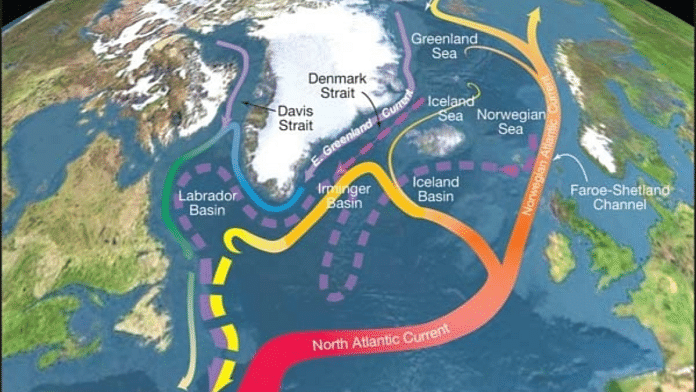Bengaluru: A study released last week, indicating that an oceanic current that regulates crucial climate and weather patterns is nearing the tipping point, has set alarm bells ringing in the science community.
According to the peer-reviewed study, published in the journal Science, early warning indicators show that the Atlantic Meridional Overturning Circulation (AMOC) could collapse within this century, leading to renewed warnings about the possible devastating effects of such an event.
The latest study, conducted by a team of researchers from The Netherlands, calls for further immediate studies into its tipping point. According to scientists, such a collapse could precipitate devastating, deadly, and large-scale climate impacts, some of which include the transition of the Amazon rainforest to a savanna and deoxygenation of the oceans triggering marine life death.
Multiple studies have indicated that the AMOC is at its weakest since the Industrial Revolution in the 1850s, with numerous climate models having it as one of the major tipping elements in our climate system. The research paper has led to a resurgence of conversation around the AMOC, its significance, and the possible effect of its collapse.
Here, ThePrint breaks down the findings of the research paper and what it means.
Also Read: Climate change deadlier than cancer, widening gap between haves, have-nots, says new UN study
What is AMOC & what drives it
As the name suggests, the AMOC is an overturning current that transports large volumes of water through the ocean, moving over 15 million cubic meters of water per second and transporting heat from the southern hemisphere and tropical regions, towards the north.
The current stretches from the Southern Ocean around Antarctica to the Arctic.
While its surface component is warmer, carrying warmer waters northwards, its convective colder component flows in the deep ocean, carrying cooler waters southward.
AMOC is one of two major thermohaline currents, or water currents driven by a combination of heat and salinity. Changes in temperature and salt content of water are behind the current, which transports warm salt water northwards.
Due to temperature variations caused by human activities since the 1850s, the strength of the AMOC has been constantly fluctuating. Increased temperatures on the surface of the sea affect the flow of the current, as does increased freshwater from melting glaciers.
Scientists have been tracking the current since at least 1950, and the AMOC is at its weakest currently.
What happens at tipping point
When AMOC reaches a tipping point, due to increased temperatures, the current will stop churning the oceans. This will then lead to large-scale temperature, weather, and climate changes.
Rainfall patterns across the globe will be affected, and this will be visible the most in the Amazon rainforest, which will transition to a savanna or grassland. In the process, it will release massive amounts of carbon, accelerating global warming.
The loss of warm currents towards Europe will see average temperatures drop across the continent, leading to an era of food insecurity. Conversely, the authors explained in a blog post in The Conversation on 11 February that sea levels will rise around the east coast of the US.
This will then prevent the growth of the oxygen- and life-giving phytoplankton.
The collapse of the current will prevent the mixing of waters, leading to stratification or layering of the ocean water. This also prevents the mixing of oxygen, leading to deoxygenation of the ocean and loss of marine life. Large-scale loss of marine life could trigger a smaller global extinction-level event and accelerate the current one.
When will the collapse occur
While on a geological timescale, we are precipitously close to a shutdown, it is not imminent immediately.
Multiple studies have indicated that the AMOC has reached a dangerous tipping point. Once it tips over, it will lead to an unstoppable decline of the current.
Studies have indicated that this could happen as soon as the year 2057. Once the AMOC hits its tipping point, it will collapse within 10 to 40 years, scientists estimate.
The new study indicates that the circulation could fully shut down by the end of this century.
(Edited by Uttara Ramaswamy)
Also Read: Mitigation alone won’t do. Joshimath showed India must prioritise climate adaptation too



